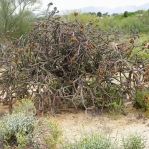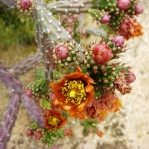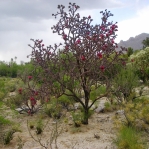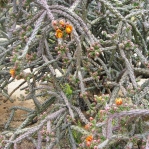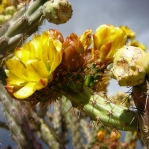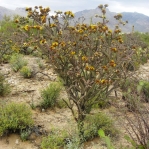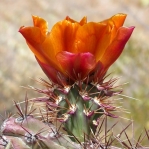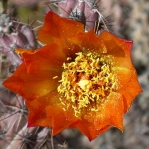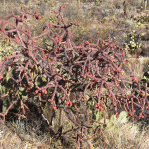Engelmann ex J.M. Coulter. 1896. Contributions from the U. S. National Herbarium 3: 452.
Herbarium specimen; Herbarium specimen; Herbarium specimen; Herbarium specimen; Herbarium specimen; Herbarium specimen; Herbarium specimen; Herbarium specimen; Herbarium specimen; Herbarium specimen; Herbarium specimen (G. ×tetracantha); Drawing (Britton and Rose v1, 1919)
Original description
Flora of North America treatment
What is Cylindropuntia versicolor?
Cylindropuntia versicolor is a Sonoran desert cholla growing from central Arizona to southern Sonora, Mexico. It grows in desert scrub, flats, washes, rocky hillsides, and canyons from approximately 600 to 1300 m elevation.
Details
G. versicolor is an openly-branching, tree-like species growing to 2 m tall, although individuals up to 4 m tall have been found. The stems are fairly firmly attached and range from 4 to 18 cm long by 1 to 2 cm wide. The areoles have 6 to 8 spines, which can be white, pink, red-brown, or grey. The spine sheaths are gray and often tipped brown or yellow. The flowers are yellowish-green, yellow, bronze, rose, or magenta with yellow-green filaments and white styles and stigmas. The fruits are yellow-green to red-purple and form chains. The fruits are often stalked and are leathery to fleshy and spineless. G. versicolor is diploid (2n = 22)
G. versicolor hybridizes with several other Cylindropuntia species including G. acanthocarpa var. major, G. leptocaulis, G. arbuscula (G. ×vivipera), and G. spinosior (G. ×granitorum). Like many plant species, G. versicolor may itself be of hybrid origin, and ongoing DNA analysis at the Desert Botanical Garden in Arizona may elucidate its parentage.
